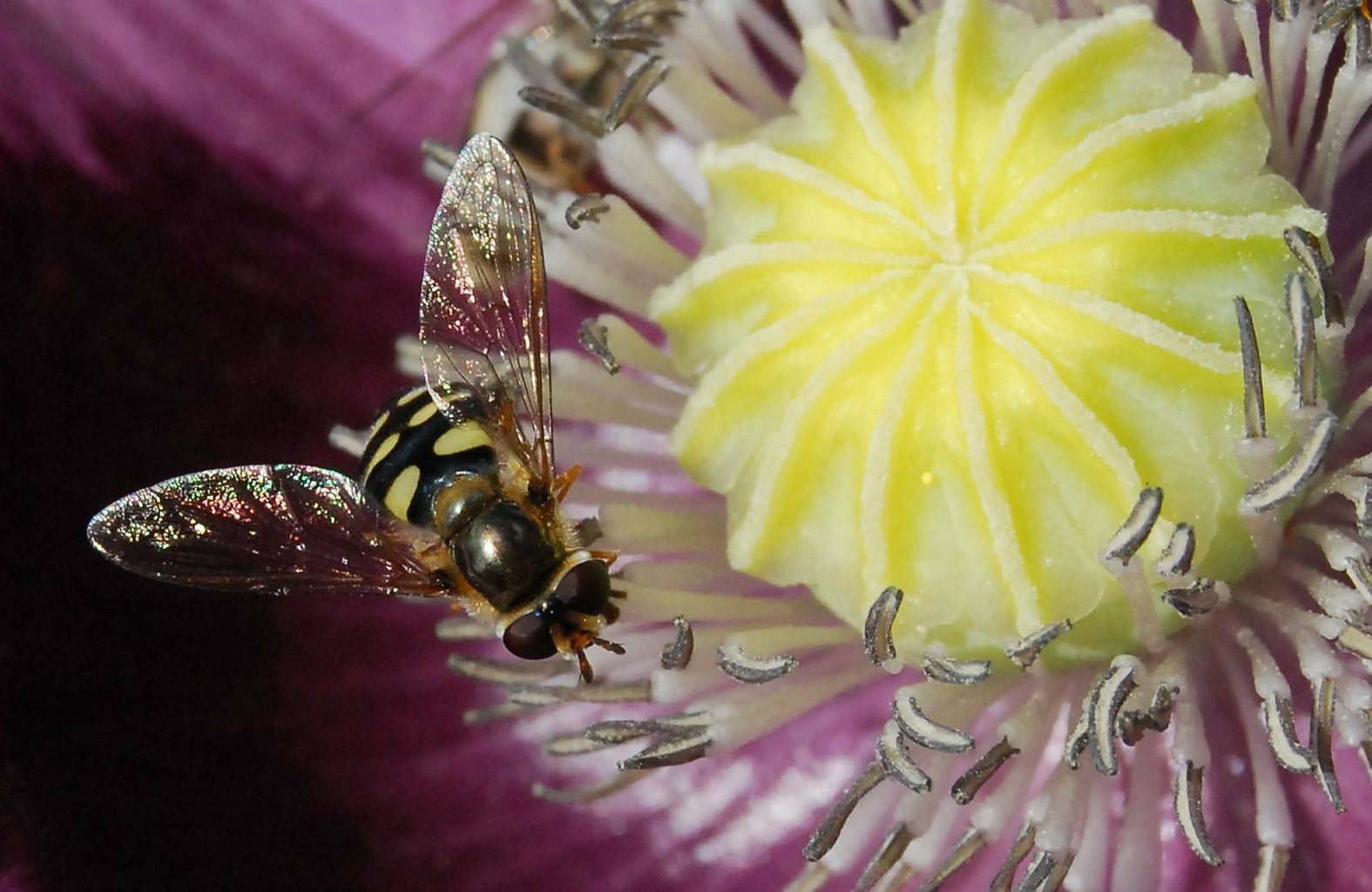
How to build an insect hotel ? : a tutorial
to attract beneficials, provide shelter and food
Contents
The insect hotel is a facility that provides “homes” or refugia for auxiliary insects and pollinators in the garden that are in short supply of housing, while optimising space.
It can accommodate solitary bees (osmias) that will pollinate your vegetable garden, lacewings, hoverflies, rove beetles, ground beetles, earwigs, parasitoid micro-wasps, and pemphredons that will be delighted to help you get rid of pests such as aphids, scale insects, slugs, or snails.
You can simply install nest boxes, shelters, and other huts or “homes for insects” sold commercially. However, you can also very easily build an insect lodge. Custom-made, it will give you the satisfaction of DIY and, as it is made entirely from reclaimed materials, this insect hotel is eco-friendly and free.
To build it, we had no plan on paper, just a lovely idea in mind! Let this detailed tutorial guide you on how to make an insect hotel, what to put inside, where to install it, and how to orient it properly.
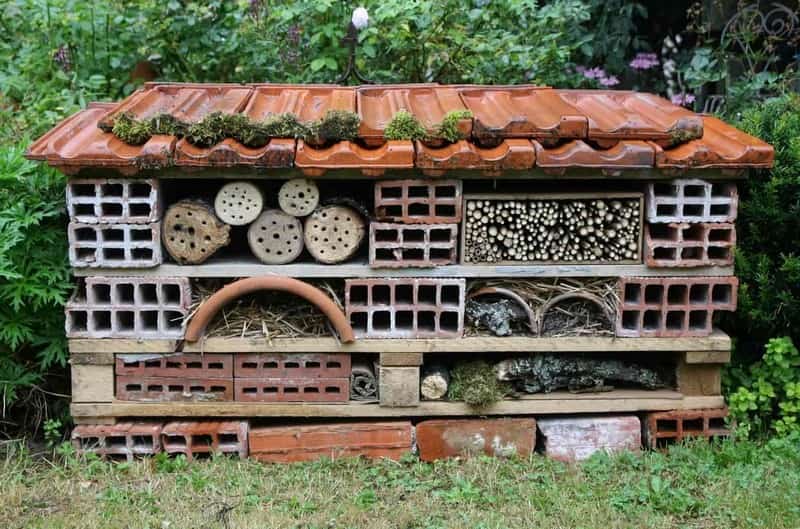
Bzzz Bzzz Hotel from Jardin Sainte Anne.
Where and when to install an insect hotel?
Orient your insect hotel so that its “front” is facing south or south-east, to ensure it receives sunlight, especially in the morning. It should be sheltered from prevailing winds and near a space overflowing with melliferous flowers (which attract pollinating insects). It should not be in contact with the soil to prevent moisture rising.
You can install your hotel at any time of the year but don’t worry: there may not be any tenants right away. It takes some time for insects to discover it. Year after year, more and more will colonise the habitat.
The necessary equipment
You can choose to use only reclaimed materials (as is the case here) or, if you have a knack for DIY, build a compartmentalised wooden hotel.
To construct this hotel, you will need:
For the structure:
- hollow or solid bricks, depending on what you find,
- pallets or wooden planks,
- tiles,
- a piece of plastic or waterproof tarpaulin (optional),
- a good drill.
For the filling:
- logs about 20 cm long, previously drilled with several holes of different diameters (from 2 to 10 mm)
- hollow stems (bamboo, reed),
- pith stems (elder, bramble, rose, raspberry…),
- straw, wood fibres or pine cones,
- clay (earth clay) + a bit of water,
- dead wood, pieces of bark,
- one or more wooden boxes (small wine crates for example),
- broken terracotta pots,
- hollow bricks, stones…
Building an insect hotel, step by step
1) The Structure
Our hotel measures 45 cm in depth and 1.20 m in width, but you can adjust according to the materials you have available. Indeed, these dimensions were chosen based on the size of the pallet we had. It was simply cut to achieve an adequate depth.
To build your hotel, start by laying hollow (or solid) bricks on a stable and as level a ground as possible. Arrange them according to the surface area of the hotel you wish to create. On top, place a pallet (cut it if necessary) or wooden planks, which work very well. In this example, this is what we later used in the absence of another pallet available.
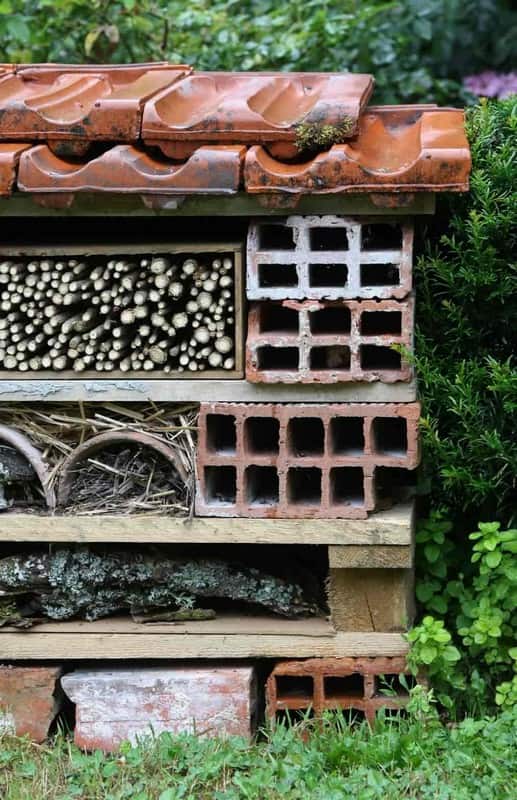
Remember to place bricks on the sides, the back, and also in the centre so that the loads are well distributed and the whole structure is stable.
Then alternate bricks and pallets (or wooden planks) like a lasagna, until you reach the desired height. Don’t forget to check the levels once the first pallet is laid. Building the subsequent levels will then pose no problem.
For added stability, do not build too high: our hotel does not exceed 60 cm in height (including tiles). Also consider aesthetics and maintain reasonable proportions according to your location and garden so that it integrates well into it.
Finish with a layer of wood, ensuring there is a slope so that water drains well. The back should therefore be higher. Place a piece of tarpaulin or plastic on top (this is not essential) and then finish by laying the tiles. There is no need to cement anything as, as the construction progresses, the weight increases and once the tiles are laid, nothing moves!
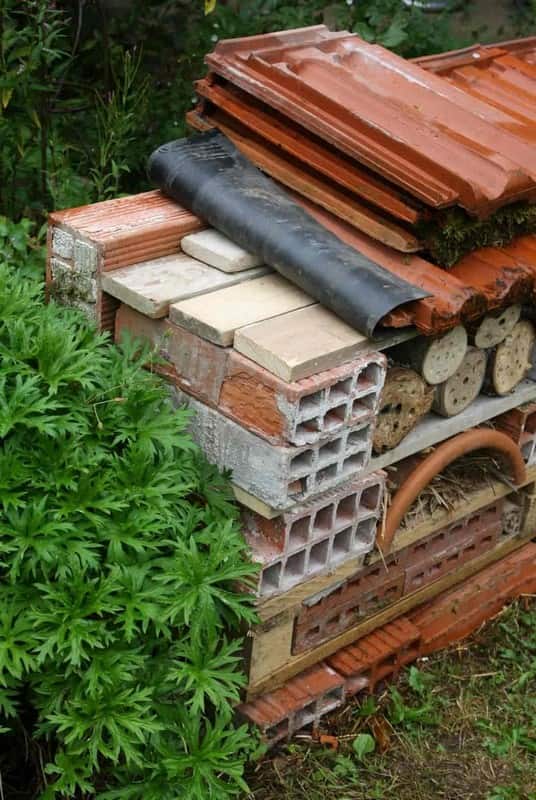
Inside the pallet, we inserted plywood panels cut to the right dimensions to fit perfectly into their slots. This is to fill these compartments without the materials being in contact with the bricks below and to limit moisture rise.
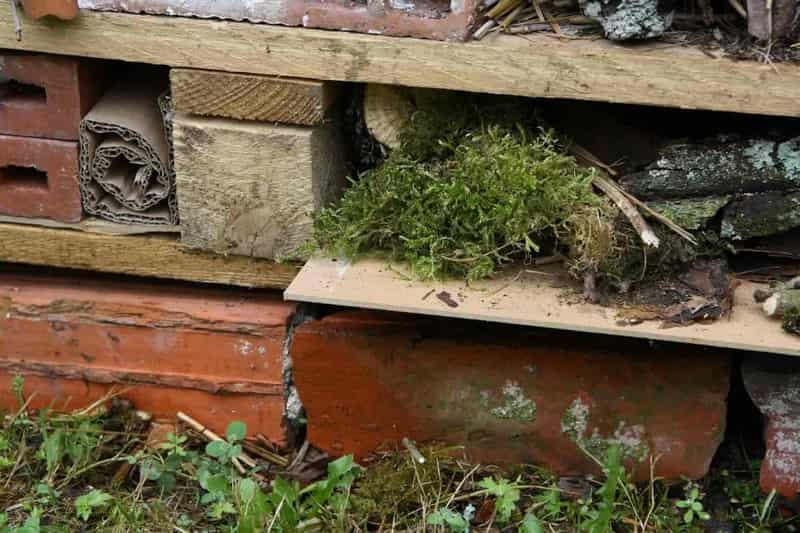
Once the structure of the hotel is complete, all that’s left is to fill it.
2) Filling the Different Compartments
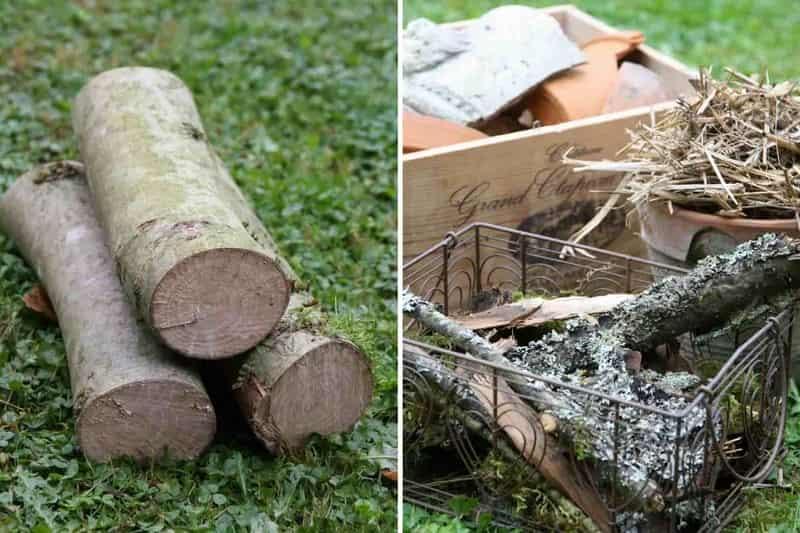
- Wood and Bark
To attract ground beetles and rove beetles, one of the compartments will be filled with a mix of dry wood, twigs, and moss.
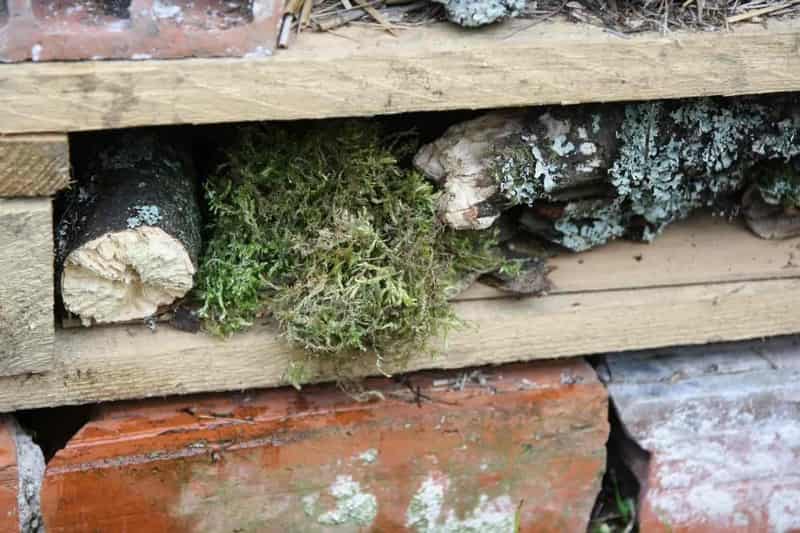
- Straw and Broken Pots
Another compartment will be filled with broken terracotta pots and dry straw for earwigs and hoverflies.
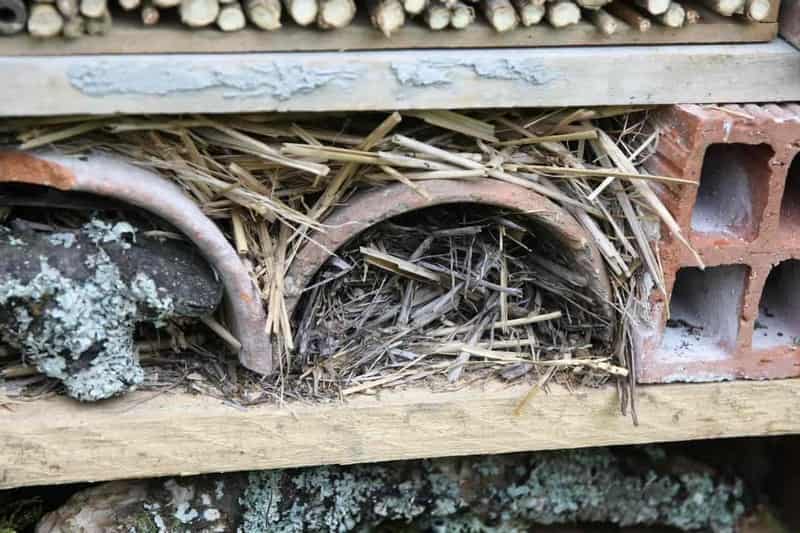
- Drilled Logs
Drill holes 2 to 10 mm in diameter using your drill. For depth, the length of the bit is more than sufficient. These drilled logs will soon be used by solitary bees, including osmias.
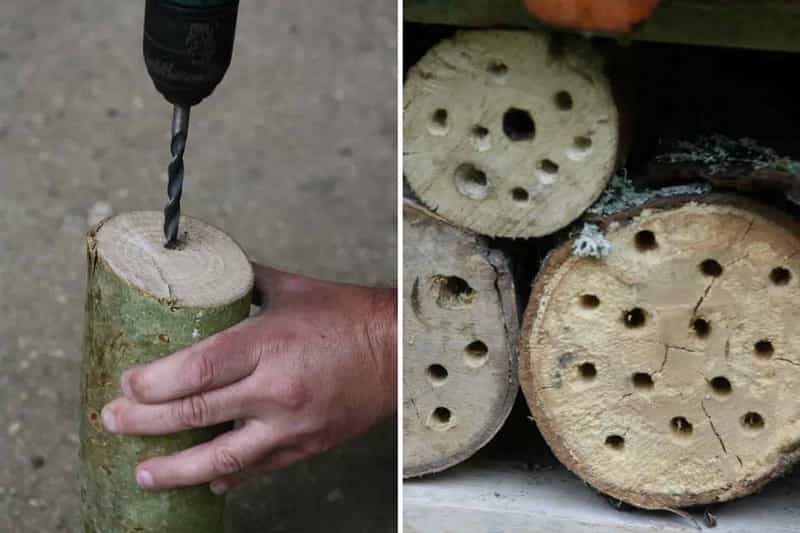
- The Box for Hollow Stems and Pith
For this part, you will need a wooden box, well-clayey soil (or clay), and a bit of water. Form a thick mud and line the bottom of your box with it. As it dries, the soil will hold the stems in place and block one end of the bamboo (if they do not have nodes). Insert your stems into the soil until the box is full. Place this in one of the compartments. Pemphredon and micro-wasps will come to lay their eggs there.
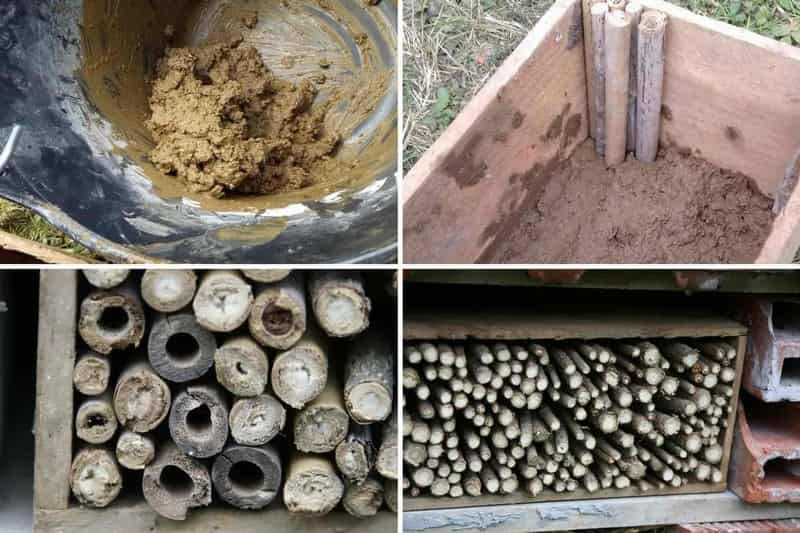
- Hollow Bricks
The structure of hollow bricks serves as a refuge for lacewings, among others. If you made your structure with solid bricks, insert some hollow bricks into one of the compartments.
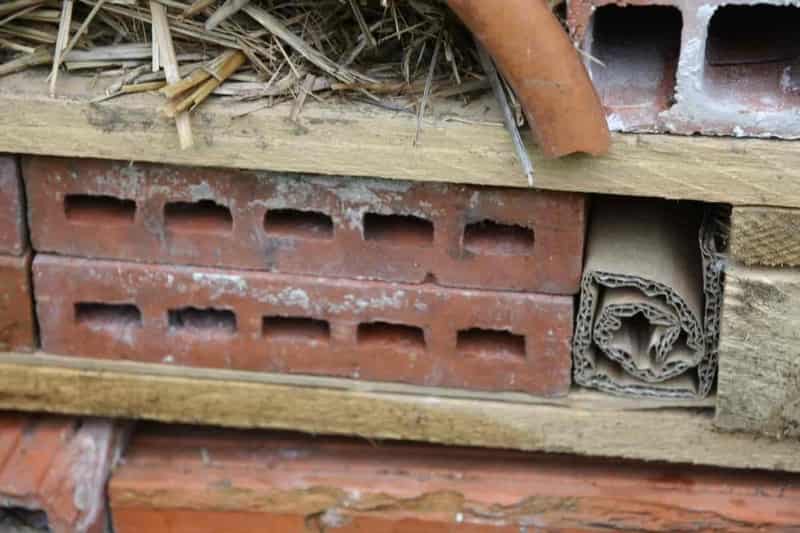
Fillings such as logs or stems can be reused by insects for several years.
Finally, building an insect hotel is a fun and educational activity! Don’t hesitate to involve children…
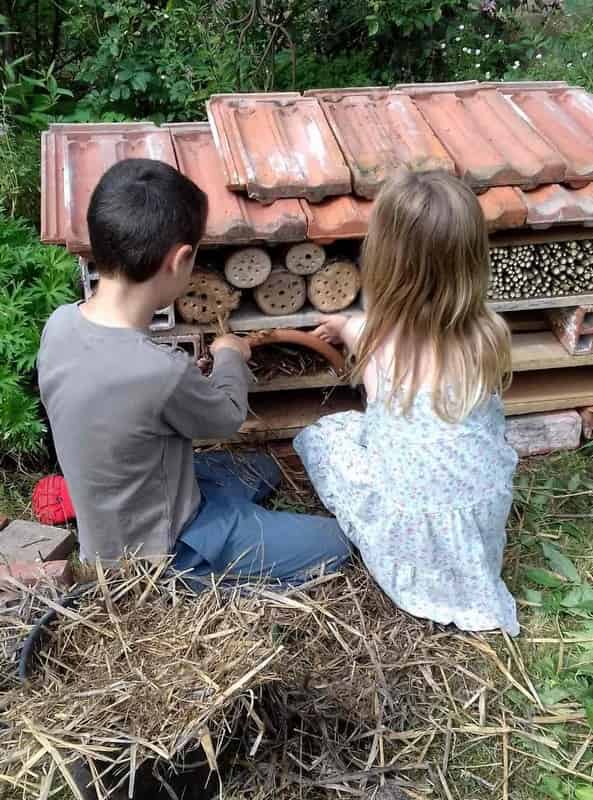
Expected tenants in our gîte
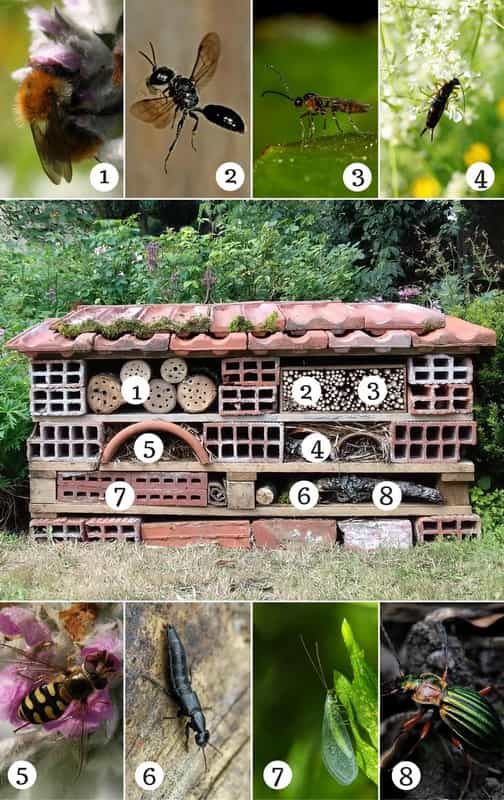
1) Honeybee
Honeybees and solitary bees are responsible for the majority of pollination in the garden. The latter appear early in spring, like bumblebees. It is essential to have a well-flowered garden and to plan for early flowering plants so that they settle in your garden and subsequently help pollinate your vegetables. Some have their preferred flowers, depending on the species of bees. It is often difficult for them to find food to forage in late winter. To support them, plant early-flowering plants: Cornus mas, winter honeysuckle, heathers (Erica), mahonia, … And to help them winter, install logs with holes 2 to 10 mm in diameter (note that the holes must always be closed on one side). Osmia are solitary bee species that are suffering greatly from the housing crisis! They appreciate logs with 8 mm diameter holes or equivalent hollow stems.
2) Pemphredon
The pemphredons are small black wasps that capture a large number of aphids to feed their larvae. This beneficial insect creates larval chambers in soft or hollow-stemmed plants, in partially decayed wood, and in galls as well.
3) Parasitoid micro-wasps (Aphidius)
Very small and discreet, these micro-wasps are highly effective cleaning agents. They can wipe out an aphid colony in no time at all. The adult female lays her eggs in or on the egg, larva, pupa, or adult of her victim. Once hatched, the larva consumes its host from the inside. The adults feed on the nectar of flowers, so a very melliferous garden will help attract them. They particularly appreciate umbellifers (Apiaceae) and Asteraceae (chicory, dandelion, artichoke…). To help them survive the winter, install hollow stems: bramble, raspberry, rose, elder in which they will come to nest.
4) Earwig
The earwigs, also known as forficulae, attack many prey such as aphids, insect larvae, and mites… They seek darkness and moisture. Some flat stones and pine cones placed high are highly sought-after shelters. You can also move terracotta pots filled with straw or damp hay as needed.
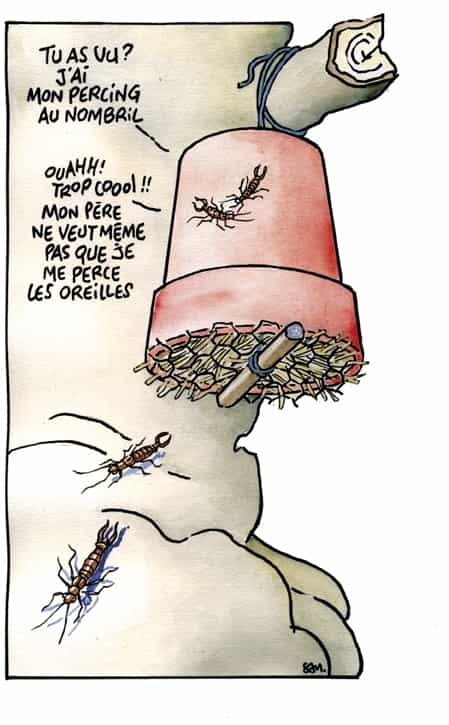
(photo : www.initiatives-fleurs.fr)
5) Hoverfly
Recognisable by its yellow/white and black striped abdomen. The adults forage while the larvae can kill up to a hundred aphids a day. They also enjoy scale insects. To encourage them in the garden, sow flowers in your vegetable patch and let some vegetables flower like dill, celery, chervil, carrots, parsley, etc. Like micro-wasps, these small flies particularly appreciate umbellifers. Hoverflies, whether larvae, pupae, or adults, can winter well protected under mulches or ground covers. In your shelter, you can provide them with wintering shelters like a box filled with straw or bundles of hollow stems.
6) Staphylin
The staphylins are elongated black beetles. They are predators of molluscs, slugs, and insect larvae. They are often victims of mechanical equipment. Create small spaces for them to find refuge: stones, tiles, piles of plant debris.
7) Lacewing or “Golden-eyed Lady”
Also known as the “lion of aphids”, a lacewing larva consumes between 200 and 500 aphids. Lacewings or golden-eyed ladies like to spend the winter in buildings: garden sheds, garages, attics, … but if your garden is far from any buildings, it is important to create natural shelters like hollow trees, hollow bricks, dry stone walls, or a box filled with straw or crumpled cardboard.
8) Ground Beetle
The ground beetles are formidable garden predators, especially at night. They overwinter as adults and come spring, they are hungry! They will easily devour young snails and slugs. Like staphylins, they are often victims of mowers, brush cutters, tillers, and other mechanical equipment. Leave wild areas where they can find refuge (tall grass, mulch, stones, old stumps…). In your shelter, install pieces of wood and bark.
Here, we have deliberately omitted ladybirds, bumblebees, and butterflies that find it difficult to inhabit shelters. To encourage their presence, leave wild corners with piles of leaves, stones, or a dry stone wall, a hollow tree, a spot dedicated to nettles, a true reservoir for beneficial insects where they can find shelter and food. Prioritise flowers like borage, nasturtium, comfrey, lavender, dandelion, lungwort, clover, and trees that flower early like willow. It is possible that ladybirds will occupy an uncleaned birdhouse to spend the winter.
Photo credits: no.2: www.bwars.com – no.3: Wikipedia – no.6: www.entomart.be – no.8: Pinterest
Useful resources
To go further:
- Nesting boxes and insect shelters by Vincent Albouy
- Beneficial organisms in my garden! from Terre vivante editions
- Leave natural shelters for garden wildlife
- Beneficial organisms, living beings useful for plant health
- Ladybirds, primroses, and blue tits from Terre vivante editions
- Discover our selection of 8 most melliferous climbing plants
- Subscribe!
- Contents































Comments